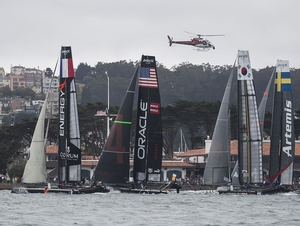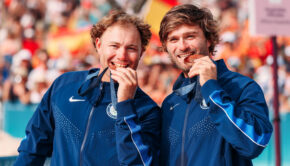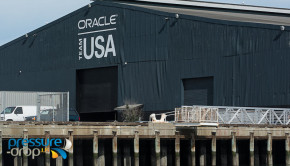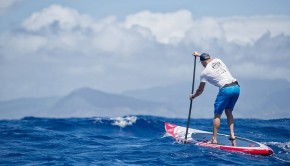Ken Read – Prepping for another lap
Published on April 12th, 2010
 (April 11, 2010) PUMA announced last week that it will participate in the Volvo Ocean Race 2011-2012 after placing second overall in the 2008-2009 competition. Led by skipper Ken Read in the last race, Read is again in charge of the PUMA Ocean Racing team, and shares his thoughts here about the team, the lessons learned in the last race, and how they seek to improve for the next race.
(April 11, 2010) PUMA announced last week that it will participate in the Volvo Ocean Race 2011-2012 after placing second overall in the 2008-2009 competition. Led by skipper Ken Read in the last race, Read is again in charge of the PUMA Ocean Racing team, and shares his thoughts here about the team, the lessons learned in the last race, and how they seek to improve for the next race.
Part 1
How active has the team been since the finish of the 2008-9 Volvo Ocean Race?
There were three or four of us that for the most part continued on. We took a couple weeks off after the finish in June 2009 and then we jumped right back into it. The process from the end of the race to the end of the year was three fold: one was to figure out what we did well, second was to figure out what we did not do well and how we would change it, and third was to find an additional sponsor that was interested in taking this trip with us.
It was a lot of work. Some of the people specifically took care of the assets, and Kimo (Worthington, team general manager) and I did the breaking down of the program for the most part, and I did most of the fundraising.
Tell us about your new partner.
BERG Propulsion makes massive variable pitch propellers for big commercial ships for the most part. It’s kind of a dream partner. What we were looking for in a partner for this project was a company that wanted to use the race in ways that PUMA doesn’t use the race. PUMA really uses the race to publicize its products, and sell products. That’s what they do….they sell stuff. There is a whole hospitality business-to-business client entertainment side of the race that PUMA doesn’t utilize and we have the capabilities to utilize it, so hence the fact we decided to go out and find another company to help defray the costs from PUMA but at the same time utilize this aspect of the campaign that PUMA doesn’t necessarily utilize enough.
BERG is a reasonably sized Swedish company that has been involved in sailing for a long time. CEO Hakan Svensson is an avid sailor, and they have not only clients but also facilities in many of the stopover areas where this race goes to, so it is a perfect match for his company to help it grow and utilize the hospitality features of the race.
Was PUMA always looking to do the 2011-12 Volvo Ocean Race?
It was always their intention to never do this just once, and without the recent financial crash, maybe it would have been a little different, and they would have been doing this next race on their own. I don’t know that, but it was always their intention to do it twice in a row. But they had to internally figure out if what they were thinking was correct. They thought it was great, but they needed to confirm if the race was really working for them. And afterwards, the answer was clearly yes.
Who do you expect to enter this next race?
I would be surprised if we didn’t see at least two America’s Cup teams enter the race. I don’t want to blow their cover, but I believe two very high profile Cup teams are about to enter the race. As for the total, I have maintained from the start that I expect to see 9 or 10 teams in the race.
When will you announce your boat and mast designers?
We are not ready to make these announcements, but we know exactly where we are at, and should be able to confirm this information within the next couple weeks. We are now about a month or so into it, and trying to make up for a little lost time compared to a couple other groups. But we certainly don’t plan to use the excuse of being a late team this time around.
I can say that, like in the last race, we have hired North Sails to help put the whole package together. We are utilizing designer Steve Calder from North Sails, who was with the Ericsson team last time, and also somewhat JB Braun who worked with us in the last race.
Part 2
In preparing for the 2008-9 Volvo Ocean Race, what proved to be an important element for success that was not fully anticipated?
What I didn’t expect was how challenging it would be to achieve good crew chemistry. We threw an all-star team together, and really just assumed that chemistry would work itself out. In almost any other boat you sail on, you throw a bunch of people together, you go sailing, and everyone gets along and life is good. But the Volvo Ocean Race is different. You are in such intense situations and you are together for so long. You are either baking hot or freezing cold, and soaking wet 24 hours a day. Things can get tense. I think more attention has to be given to seeking good chemistry. It is not that the people are good guys or bad guys; it’s just that things get tense and we need to find exactly the right mix.
The winning team Ericsson 4 made no crew changes in the last race, while every other team made changes. You said your plan all along was to have a crew rotation, but were your crew changes ultimately about both providing rest and seeking better chemistry?
Yes, they were probably a little bit of both. A crew rotation in the last race was our game plan from the start, and we are talking about that long and hard right now for this next race. What is the right mix? Once you do find the right chemistry, is it then trying to go around with exactly the same group or do you still implement a rotation? Last time I was committed to it (the rotation), that was our idea from the start and that’s how we signed people up.
So we stuck to our position on that. Jerry Kirby was a perfect example, as he simply could not do the whole race as he has a ‘real job’ managing his construction company. But we wanted him involved, so his legs were pre-planned before the race started. So do you stuff like that again, or do you try to go all the way around with the same group? We are right in the middle of that debate right now.
I think you find historically that the better the team, the fewer the crew members. Both of the last two winners (ABN AMRO ONE and Ericsson 4) went around with exactly the same crew. Everybody always talks about how E4 seemed to have great chemistry and the rest of the fleet didn’t. Well, I am not sure they did have great chemistry first of all, but winning sure does breed happiness.
What are some of the aspects of the last campaign that you will seek to improve on?
Besides improving the crew chemistry, we need to improve our organizational structure. We need to become less reliant on a few people to make every big decision and more reliant on the team coming together as a team. There is a million ways to skin this cat. In the last race, we threw a team together that did a spectacular job, and I am deeply indebted to every single person last time around, but we do want to change up the attitude a little bit and how we go about handling the little details. Whether it is working on the boat, putting together logistical details, dealing with the sponsor, dealing with the race management… I just think every single aspect in its own way can get better. By doing so, every individual and entity involved in this program benefits; they feel like they are move a part of the operation. When you enjoy what you do, you tend to be more successful.
When do you hope to confirm your crew roster?
Fairly soon. It is such a hard call. Would we like to do tryouts? Perhaps, but it is really hard to do tryouts. Fortunately we have several guys from the last program that most likely will be coming back. We still have plenty of work to do on getting everyone signed up on contract. We have a fair idea of who is coming back from last time and who our core group is from outside of the program. With the number of crew required to be under 30 years now increased from one to three, it makes that decision difficult, but we are lucky as we sailed with three under 30’s in the last race, just because they were great crew. So we might have a little more flexibility than most as we already have trained under 30’s available to us. Hopefully we are not going to be in a tryout situation, which would be unfortunate for the sailing world, but fortunate for our program as we already have a pretty good idea of where we are going to be at.
Part 3
What is your opinion of the new route for the 2011-12 Volvo Ocean Race.
The new route is what it is. Everybody has an opinion, but somebody else makes up the rules, and if you want to play the game, you abide by them.
I would say among the big changes is the leg from Cape Town to Abu Dhabi… lord only knows… I don’t even know where to start about that leg. I don’t think we are going to have USA 1498 on our sail for that route. It’s going to be interesting. I haven’t talked to race management specifically about safety measures going up either past Somalia or Iran. It certainly isn’t a very popular place in the world to go cruising, but at the same time, when we get up to the area where we are finishing, I haven’t been there but I understand it to be just gorgeous. So part of me says this is a cool new adventure yet there is for now a slight amount of apprehension.
From there on, not having to go all the way north into the winter of China was obviously a pretty good move. Stopping half way in Auckland on what was a very long leg in the last race (from China to Brazil) was in my opinion a very good move too.
On picking Miami over Newport, I wouldn’t be human if I didn’t say I was disappointed by that, but PUMA purposely did not get into any of the politics of stopover decisions. We just decided that wasn’t our game and for PUMA, it didn’t really matter between Miami and Newport. In fact you could probably make a case commercially that Miami was better for PUMA. But at the same time, with PUMA being based in Boston, it would have been nice to have that hometown feel for both our sponsor and, of course, our program (the team will be training out of Newport). Sailing into Newport would have been a pretty fun experience. But, it didn’t happen, that’s life, and we move on and try to turn Miami into a hometown feel.
You noted that your budget for the next race will be about the same as the last race. With the new route reduced from 10 legs as in the 2008-9 race to 9 legs for the 2011-12 race, will this change provide a cost savings for each team?
Well, I know that in the last race each stopover cost us a minimum of a quarter million dollars.
Other than the route, what are some of the significant changes made by the race management for this race compared to the last race?
The reduction of sails allowed will potentially make the boats a lot different to sail, and create some design challenges in creating the sail inventory. Then there are changes in how you can stack the sails, like in how you can’t put stuff behind the back bulkhead (note: stacking of sails and equipment is restricted to the mid section of the boat below deck). I don’t think the rules limiting the amount of testing days will change the race much, but there is now a total ban on two-boat testing (still to be announced, but no two-boat testing allowed any earlier than 8 weeks before the start date). This will keep a team like Ericsson from sitting on an island in the middle of the Atlantic ocean, going out and testing all day, every single day (note: their training base was in the Canary Islands). I think this change is a good thing for the race. Very few people have the ability to do it, so why not get rid of it. And that is what they did.
When do you hope to launch your new boat?
This is another debatable question. This is the age-old battle of either giving the designers as much time as they want, which means you launch nine minutes before the start, or giving the sailors the time they want and launching three years before the start. Where is the happy medium? The designers are actually doing an analysis on how much extra work they could get done in a period of time leading up to the race. Once we get those facts we will be much better educated on when to make a decision to start the boat.
Part 4
You have said your boat for the 2008-9 Volvo Ocean Race was a very good all-around boat. But the Telefonica boats had an edge in light air, and the Ericsson boats had an edge when reaching. For this next race, are you looking to go more into a design corner to seek an edge?
This is another highly debatable subject. I think the bigger question is whether Ericsson 4 was an all-around boat. We know the Telefonica boats weren’t an all-around boat, and really had an Achilles heel in the breezy conditions in trying to maintain control. And sure enough, they won a bunch of legs and did badly in a bunch of legs, while we were generally getting seconds and thirds.
As for Ericsson 4, were they enough of an all-around boat, or did they happen to just be really good, or did they stick the design into a corner and give up light air performance, as for example, ABN AMRO ONE did?
In the 2005-6 race, the winner ABN AMRO ONE very clearly made a boat that had dominant speed on a reach, and had a huge Achilles heel in light air, but it never really showed up in that race.
I think it is really a question of whether E4 is enough of an all-around boat for your liking, and then go from there. It just so happened to be pretty nice in a breeze, especially reaching.
I am really enjoying the design part of the project. It is fun having these internal debates, and sitting down with smart people and discussing these questions. I am much more involved in the design phase this time because we have a little more time, and it has been good fun so far.
What is not yet known about this next race that you are eager to discover?
I am eager to learn whether the old boats will remain competitive, as they theoretically can be, and I think a lot of us hope they will be.
Due to the rule changes, the newer boats may not be as stiff, the keel and bulb weights will be lighter, and the boats will be heavier so that you don’t spend a fortune on getting every last kilo into the bulb. The last 5% of a Volvo boat costs about 25% of the total boat as you have to work so hard to optimize the weight. However, these rule changes should result in the new boats not being quite as stiff.
As far as I am concerned, it is important for the future of the race that boats don’t just go around once, so the outcome of this issue may prove to be vital down the road.
Have you heard any specifics concerning the In-Port races?
The race management has implied there will be an In-Port race at every stop, including the finish.
Are you still employed with North Sails?
I am technically still employed by North Sails, but I remain officially on a sabbatical. I do not currently hold any day-to-day capacity, but certainly am available as needed and as my time permits.
Will we see a return of PUMA City at the stopovers?
There will certainly be a version of PUMA City at all the events. It was a huge success for the last race in both Alicante and Boston, but it is a massive a structure. So it may be the same exact one or a scaled down version almost everywhere. PUMA has signed up again as the official licensing partner for all the Volvo Ocean Race merchandise, and they will look to expand on what they learned last time, and seek to sell a lot of product to people who are very interested in the race. A facility like PUMA City helps to do this. It was a focal point in the village, it was really fun to be at, particularly the upstairs bar and lounge area.









 We’ll keep your information safe.
We’ll keep your information safe.